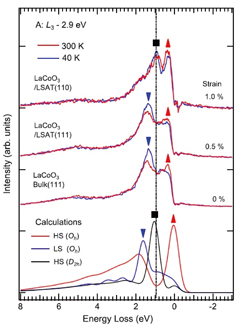Tensile-Strain-Dependent Spin States in Epitaxial LaCoO3 Thin Films
Y. Yokoyama, H. Wadati, and Y. Harada
In transition metal compounds, charge, spin, and orbital degrees of freedom by a strong electron correlation realize various physical phenomena such as superconductivity, metal-insulator transition, and charge ordering [1]. The perovskite-type cobalt oxide LaCoO3 is one of the most interesting materials because of its various electron degrees of freedom. Since the spin state of LaCoO3 is sensitive to the crystal field, a spin crossover from the low-spin (LS) to high-spin (HS) state is shown by increasing the temperature [2]. Epitaxial strain can also influence the spin states and a ferromagnetism is observed in LaCoO3 thin films at lower temperatures (≲85 K) [3–5]. In previous studies, the spin states of the thin films were considered by the orderings of 3d electrons on the basis of resonant x-ray diffraction [3–5]. However, direct observations of the electronic structures are important to clarify the spin states. Since it is difficult to determine the spin states by conventional techniques such as x-ray absorption spectroscopy (XAS), we performed resonant inelastic soft x-ray scattering (RIXS) with Co 2p → 3d → 2p process (L edge) [6]. The RIXS is one of the most powerful techniques to clarify the spin states by observing the d-d excitations.

Fig. 1. Comparison of the experimental RIXS spectra excited with A: L3 −2.9 eV (776.5 eV) measured at 40 and 300 K and the theoretical ones in Oh and D2h symmetries.
The LaCoO3 epitaxial thin films (30 nm thickness) were fabricated on LSAT(110) and LSAT(111) [(LaAlO3)0.3(SrAl0.5Ta0.5O3)0.7] substrates by pulsed laser deposition technique. The same substrates with different orientations enable us to observe the pure strain effects on XAS and RIXS spectra. The lattice constant of the LSAT substrate is 3.868 Å, while that of the LaCoO3 bulk is 3.804 Å, indicating that tensile strains are applied to the LaCoO3 epitaxial thin films grown on LSAT substrates. The magnitude of the tensile strains from LSAT(110) and LSAT(111) substrates are 1.0% and 0.5%, respectively (strains are defined as the ratio of the cubic root of the unit cell volume) [3,4]. The experiments of XAS and RIXS were performed at BL07LSU HORNET, SPring-8 [7]. The RIXS measurements were performed with soft x-ray from 770 to 810 eV (Co L3 and L2 edge). In the range of the x-ray energy, the energy resolution is ~ 300 meV.
The comparison of the experimental RIXS spectra excited with A: L3 −2.9 eV (776.5 eV) measured at 40 and 300 K and the theoretical ones with several electronic states are shown in Fig. 3. The peaks observed at around 0.3 eV is assigned to the excitations from the HS ground states. On the other hand, the peaks at 1.3 eV observed correspond to the excitations from the LS ground states. However, the peaks at 1.0 eV in LaCoO3/LSAT(110) cannot be explained by either the LS or HS with Oh symmetry. By comparing with the theoretical spectra, the peak for the HS state is shifted to 1.0 eV by lowering the symmetry from Oh to D2h, indicating that the spin state of LaCoO3/LSAT(110) consists of the HS states with different local symmetries, i.e., the mixture of Oh and D2h symmetries.
In this study, we performed RIXS measurements and revealed that the spin states of Co ions were different between the bulk crystal and the thin film crystals. Although it is difficult to observe the strain effects on the spin states with conventional XAS measurements, clear difference can be probed with the use of RIXS.
References
- [1] M. Imada et al., Rev. Mod. Phys. 70, 277 1039 (1998).
- [2] M.W. Haverkort et al., Phys. Rev. Lett. 97, 176405 (2006).
- [3] J. Fujioka et al., Phys. Rev. Lett. 111, 027206 (2013).
- [4] J. Fujioka et al., Phys. Rev. B 92, 195115 (2015).
- [5] Y. Yamasaki et al., J. Phys. Soc. Jpn. 85, 023704 (2016).
- [6] Y. Yokoyama et al., Phys. Rev. Lett. 120, 206402 (2018).
- [7] Y. Harada et al., Rev. Sci. Instrum. 83, 013116 (2012).
